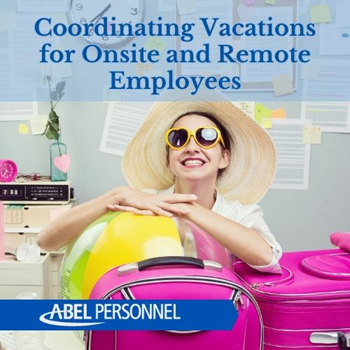A small part of Peter’s job as the Assistant Manager of the Accounting Department was coordinating staff vacations. All staff vacation requests needed to be submitted by the end of May. By mid-June he was expected to produce a calendar that indicated when each person was on vacation over the summer. Of course, this was more complicated than just recording each person’s plans. Compiling a vacation calendar also entailed:
- Assuring Critical Task Coverage: Confirming, per policy, both accounts receivable employees cannot be gone the same week, nor a department’s manager and assistant manager. Payroll clerks may not be absent on pay dates.
- Scheduling Temp Coverage: Having a cut-off date for communicating vacation requests is helpful. Certain administrative positions require that someone be there to answer the phones, schedule meetings, or assist in assembling reports. Abel Personnel has been the go-to source for providing short-term vacation coverage for these types of roles.
- Identifying Back-ups: Each person on a vacation of 2 or more days needs to identify who will receive their phone calls in their absence. These assignments had to be backchecked to confirm the designated person also was not on vacation. He had to also confirm that out-of-office email responses were in place as well as changed to the recorded voicemail message.
- Enforcing Policy: At one time, this was a matter of confirming that the days off did not exceed available paid vacation days. Lately, some staff scheduled unpaid vacation days (sometimes leaving a department shorthanded, having to hire a temporary employee), or forgoing vacations (despite “use-it-or-lose-it”) in order to gain favor as an uber-committed employee. Company policy required everyone to take at least one full week of (paid) vacation, so those who did not submit a vacation request also need to be contacted.
This effort resulted in an online calendar accessible to all in the company; processes continued despite absences or were planned around the absences of critical staff on certain projects.
During the pandemic, when 90% of the staff worked remotely, there had been a shift in this task. Coverage for reception and onsite security were not an issue. Many of the vacations were staycations, with staff willing to “come back” from their vacations early as needed. With the mandate in early 2023 to have most employees return onsite, Peter discovered there were new challenges:
- Onsite Coverage Depth: Can an employee who works remotely cover for an onsite employee with in-person client-facing responsibilities? Does the remote employee need to be onsite that week?
- Virtual Temp Coverage: For those positions where a short term temp coverage was needed, can a remote temp perform the required duties without in-person supervision, whether or not the person on vacation was onsite or remote?
- Hybrid Vacations: This was a new phenomenon from the pandemic. An off-site employee books a beach home for two weeks, being there one week on vacation and one week as a remote employee. Now that this employee is based onsite; is this still an option?
As Peter raised these concerns at a weekly HR Department meeting, there were a few chuckles. These were added to the list of needed policy manual changes that were the unexpected consequences of the pandemic. Later, his contact at Abel Personnel assured him that she also was hearing of these new concerns from her client companies, and was already screening temps for both onsite and virtual positions.



